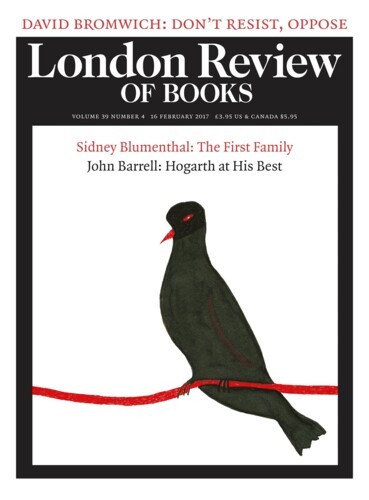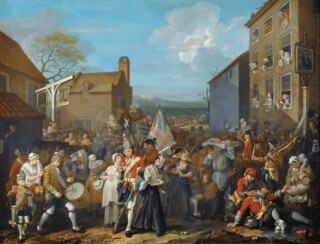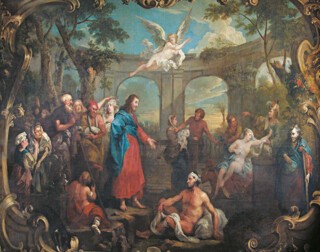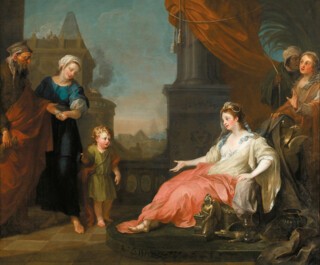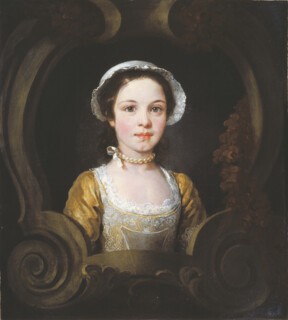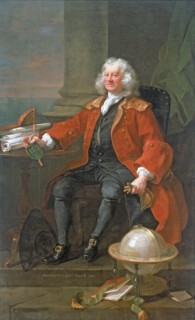The word ‘Hogarthian’ first appeared in print in 1744, in a translation of La Fontaine’s The Loves of Cupid and Psyche. By this time Hogarth had become well known, in particular, for the engraved versions of his graphic novels: the ‘progresses’, illustrating the lives of Tom Rakewell and Moll Hackabout, and Marriage à la Mode, the story of the disastrous arranged marriage of a city merchant’s daughter to the son of an earl. By issuing these and other series of his paintings as prints, Hogarth had gained more currency for his work than any other 18th or early 19th-century painter. There was no other whose name was commonly adjectivised: we don’t find ‘Reynoldsian’, for example, or ‘Turnerian’, in familiar use. But how far these prints were ‘Hogarthian’, as that term came to be understood, is debatable. The OED defines it, capaciously enough, as ‘of, relating to, or characteristic of William Hogarth or his style; resembling or characteristic of the subjects depicted in Hogarth’s work’, and explains that ‘much of the work of Hogarth is characterised by the use of satire to examine questions of morality, and often features vivid characterisations of the disreputable side of 18th cent. English life.’ But the quotations cited in support of this definition seem to tell a different story. They include a letter of 1829 by Charles Lamb, in which he speaks of ‘true broad Hogarthian fun’, and an essay by Carlyle of 1837: ‘There is nothing more Hogarthian comic.’ Next comes Swinburne, fifty years later, speaking of ‘an excellent Hogarthian comedy, full of rapid and vivid incident, of pleasant or indignant humour’. In 1978 Cecil Beaton attributes to the society philanthropist Lady Anne Tree ‘an oversize personality and character – rorty, Hogarthian and with exquisite understanding of character’, and in 2003 a writer in the Economist evokes a ‘Hogarthian throng of cheerful tradesmen and naughty ’prentice boys’.
In a thoughtful essay Lamb himself attacked the notion that what is most Hogarthian about Hogarth is what is most broadly comic, most boisterous, most fun. This, he claims, is ‘the vulgar notion respecting Hogarth’, exemplified in particular in a critique of his work by the Irish painter and critic James Barry. Acknowledging Hogarth’s merit – his ‘admirable fund of invention’, the moral quality of his satire, ‘seldom or never employed in a dishonest or unmanly way’ – Barry had nevertheless claimed that his ‘general aim’ was not to ‘reach the heart’, but only to ‘shake the sides’.
As thoroughly Hogarthian as anything else by Hogarth, in the terms, at least, of the quotations in the OED, is the magnificent March of the Guards to Finchley (1750), in the Foundling Museum, formerly the Foundling Hospital, near Russell Square. There are only three Hogarths there, but it is absolutely the best place to enjoy his amazing variety without getting tired. The scene of the March of the Guards to Finchley is Tottenham Court Road turnpike, looking up towards Highgate on its distant, sunlit hill; on one side of the road is a pub, the Adam and Eve, on the other a four-storey inn-cum-brothel, with whores leaning out of every sash window and looking down on the mayhem in the street below. During the Jacobite invasion of 1745, this is where soldiers were required to muster prior to marching off to the encampment on Finchley Common and thence northwards; but those who have come to report for duty look in no condition, physical or emotional, for military service. In the centre of the painting is a sergeant, wielding the halberd that denotes his rank, and vainly trying to keep in order a noisy, drunken rabble of grenadiers. In front of him stands the most sober of them, a handsome guard, whose farewell to his pregnant girlfriend, a poor but pretty ballad-seller, is being violently interrupted by an older woman who may be his wife, and who, if we believe the account of the picture by Hogarth’s friend Jean André Rouquet, is also pregnant. The two women are rivals in politics as well as in love, the younger selling pro-Hanoverian papers, the older Jacobite ones. Apart from a very upright guard in front of the brothel, who has something of the air of Jacob Rees-Mogg, this handsome grenadier is the best behaved of the lot. Among the others, one has a painful case of the chaude-pisse, and is urinating against a fence bearing an advertisement for a quack cure. Another is kissing a young milkmaid, and feeling her up under her bodice; the milk slopping from her pail is eagerly scooped up in his hat by another soldier. Yet another filches a pie from the tray of a pie-seller; another has punctured a barrel of gin carried by a porter, and is catching its contents in his water-bottle; a third has fallen down drunk, but turns his head away from the water offered by a barely more sober comrade while making a grab for a noggin of gin being poured out by a sutler.
The picture is a soundscape of sorts. In the front foreground are a noisy drummer and a little soldier-boy fifer, together playing the tune that summons the guards to muster to the colours; the drummer is too intent on the din he is making to acknowledge the anxious farewells of his wife and son. On the far right is a young horseman, waving his hat and crying the news, perhaps of the victory at Culloden: a sign advertising ‘Tottenham Court Nursery’ bears the appropriate date, 1746. The general hubbub in the front of the painting is subdued, however, partly by images of quieter actions and incidents – though in the inn yard on the left a crowd is gathered around two soldiers engaged in a bare-knuckle boxing match – but mainly by the aerial perspective, which softens the lines and colours in the middle ground before giving way to a bright distance, where we discover a column of guards marching off to Finchley in three orderly ranks, their bayonets, red coats and white spatterdashes all gleaming in the April sunshine.
Depending on which source you believe, George II was either fascinated or appalled by the painting. ‘Pray,’ he is said to have asked a nobleman in waiting – and if he did, he revealed himself as still to be fully acculturated in his kingdom of England – ‘who is this Hogarth?’ ‘A painter, my liege.’ ‘I hate bainting, and boetry too! Neither the one nor the other ever did any good! Does the fellow mean to laugh at my guards?’ ‘The picture, an please your majesty, must undoubtedly be considered as burlesque.’ ‘What! A bainter burlesque a soldier? He deserves to be picketed for his insolence! Take his trumpery out of my sight.’
Rouquet got rather closer to Hogarth’s intention: as a Frenchman he must have understood that the picture was in part directed against his own nation, and he was word-perfect in the terms of ideological conflict between France and England. He pointed out the orderly discipline of the marching column, so much in contrast with the drunk and disorderly guards in the front of the picture. But if you complain about the ill-discipline in the foreground, he explained, you’ll simply be told that order and subordination are suited only to slaves (such men as the starving ‘soupes-maigres’ depicted in Hogarth’s Gate of Calais). ‘What is known everywhere else as “license”, is called in England by the august name of “liberty”.’
Samuel Johnson would make the point still clearer in his essay ‘The Bravery of the English Common Soldiers’. Why is it, he asked, that the ‘English vulgar’ make such excellent soldiers, willing to follow wherever their officers lead? It was not, he thought, that they wanted to fight in defence of liberty, for they enjoyed no more of that than ‘the lowest rank of every nation’. ‘It proceeds,’ he wrote, ‘in my opinion, from that dissolution of dependence’ which characterised social and economic relations between the classes in England. ‘Thus every man that crowds our streets is a man of honour, disdainful of obligation, impatient of reproach, and desirous of extending his reputation among those of his own rank; and as courage is in most frequent use, the fame of courage is most eagerly pursued.’
This is the point, presumably, of the boxing match in the inn yard, and the point, too, of Hogarth’s evident delight in showing the guards at their boisterous, undisciplined worst in the foreground of the picture. Johnson acknowledged that ‘some inconveniences may from time to time proceed’ from this ‘neglect of subordination’. But ‘they who complain, in peace, of the insolence of the populace, must remember, that their insolence in peace is bravery in war.’ Hurrah!
As Elizabeth Einberg puts it, The March of the Guards to Finchley is ‘a work that aims to be both “serious and comic” in the fullest Hogarthian sense’. However reprehensible the behaviour of the grenadiers, the painting permits us to enjoy their drunkenness, their whoring, their thieving, their sexual assaults as ‘true broad Hogarthian fun’ because, look, they are as disciplined as we could wish when commanded to be. The picture seemed to ask to be displayed in the Foundling Hospital, where it would teach a perfect lesson to the boys it was preparing for life after they left the institution. The hospital regarded the armed services as its charges’ best future destination, and the picture showed that the progeny of London low-life could be successfully recruited into an elite army regiment. It could probably persuade the older male foundlings, if they were ever admitted to the room where the painting was hung, that, once old enough to join the adult world outside, they would be able to enjoy all the fun their missing and presumably irresponsible fathers had enjoyed with their mothers, along with all the dignity, and opportunities for heroism, here attributed to the smartest of marching regiments. More probably it would be seen by the visitors to the hospital, by the patrons and staff, whom it might reassure that the very sweepings of the London streets were not beyond redemption by military discipline.
But Hogarth faced a dilemma. However appropriate a gift to the hospital, however much such a gift would enhance his moral standing in London, a painting so colourful, so beautifully painted, so full of life, so packed with jolly anecdotes, would be bound to fetch a more than handsome price if offered for general sale. Might there not be a way of having his cake and eating it too? Hogarth’s answer was to advertise a ‘subscription’, a raffle. Visitors to his studio were invited to inspect the painting there, where they could buy one or more of two thousand raffle tickets. When the subscription closed, 167 tickets remained unsold, which Hogarth donated to the Foundling Hospital, and by happy chance the winning ticket was among them.
‘It may be reasonably doubted,’ wrote Barry, in the essay that Lamb took issue with,
whether the being much conversant with Hogarth’s method of exposing meanness, deformity, and vice … is not rather a dangerous, or, at least, a worthless pursuit … Life is short; and the little leisure of it is much better laid out upon that species of art which is employed about the amiable and the admirable, as it is more likely to be attended with better and nobler consequences to ourselves.
Barry believed that true art was made not by ‘paddling in whatever is ridiculous, faulty, and vicious in life’ but ‘in the constant pursuit of all that gives a value and a dignity to human nature’ – the pursuit, in short, of history painting in the grand style, the highest of the genres of high art, which he himself pursued, but which few other artists in Britain, so he believed, had a taste sufficiently elevated to attempt. By his mid-career, Hogarth had become thoroughly impatient with all the ‘puffing’ and ‘pother’ made about the grand style, and irritated too by the suggestion that he could aim no higher than the ‘modern moral subjects’ which, in Joseph Andrews, Fielding would praise as ‘comic history painting’, as if Hogarth was doomed by a low taste and confined ability to be merely Hogarthian. The grand style, Hogarth believed, was ‘more easily attainable than is imagined’. When the governors of St Bartholomew’s Hospital determined that their new staircase should be decorated with history paintings, Hogarth won the commission by offering to do the job for nothing, and, ‘with a smile at my own temerity’, produced two ambitious pictures of appropriate subjects: The Good Samaritan, depicted pouring oil and wine into the wounds of the traveller from Jerusalem, and The Pool of Bethesda, in which Jesus tells a lame man to take up his bed and walk.
The establishing of the Foundling Hospital offered Hogarth a similar opportunity to demonstrate his ability as a painter of biblical subjects, and his public spirit in painting one without charge. The subject was again thoroughly appropriate: the infant foundling Moses brought before Pharaoh’s daughter to be formally adopted. Once more, there is nothing Hogarthian, in the sense of the OED’s quotations, about the painting. It was closer to the subjects by which Hogarth had made his early reputation – small ‘conversations’, often of family groups, sometimes including children – but they had none of the pathos of this work, in which Moses weeps as he leaves the care of the woman who has nursed him, and who, unknown either to him or to Pharaoh’s daughter, is his natural mother. His mother weeps too, as she receives her nurse’s wages and relinquishes her boy. The scene, explains Einberg, parallels ‘the procedures of the institution itself: babies, abandoned in desperate circumstances … were placed with a wet-nurse in the country until weaned, being returned to the hospital to be brought up to become useful members of society. The procedure was far from perfect in practice, but the ideal was here for all to see.’
Pharaoh’s daughter, a woman of gentle beauty, makes herself as welcoming as possible, extending a kindly hand and leaning back in her chair in a pose that would look languid in some contexts, but here seems to suggest a desire to make herself as unthreateningly small as possible. Einberg remarks that she may be modelled on the Countess of Pembroke, ‘an active patron of the Foundling Hospital’, and if so, it would be appropriate to an effort by Hogarth to emulate the great painters of the Italian Renaissance, who often painted portraits of their patrons as actors in biblical events.
It would, however, be very untypical of Hogarth. In a superb short essay on his portraits, Mark Hallett wrote of Hogarth’s ‘prickliness when dealing with more socially elevated patrons’ as one reason his portraits were very largely of men from the ‘mercantile, professional, ecclesiastic and scientific spheres’ and their wives – not from ‘fashionable, metropolitan, aristocratic society’. Men and women from ‘the middle station of life’ were believed (at least by writers in the middle station of life) to be the most natural, the best embodiments of human nature. ‘The great,’ as Hume put it, ‘are too much immersed in pleasure, and the poor too much occupied in providing for the necessities of life’; the bodies of the latter were deformed by hunger and by the work needed to satisfy it; those of the former were distorted by the postures imposed on them by the need to conform with fashionable behaviour. The middle classes avoided both extremes, but the middle class Hogarth depicted were not therefore ‘divinities’, models of ideal perfection, the ‘central forms’, as Reynolds put it, of the human figure. His sitters, Hallett writes, ‘squat’, or ‘solidly built’, were sometimes received as mere caricatures, because they ‘consistently refuse to conform to the elongated bodily ideal prized in more elite circles’. ‘By some,’ Hogarth wrote, ‘they were said to be nature itself, – by others, declared most execrable.’
Einberg’s catalogue, very thoroughly researched and nearly twenty years in the making, is an immensely valuable publication, especially valuable perhaps for the excellent reproductions it contains of all Hogarth’s extant portraits. Many of course are already very well known – Garrick as Richard III on the eve of the Battle of Bosworth, Garrick and his wife Eva-Maria Veigel, the painting known as The Shrimp Girl, the self-portrait of Hogarth with his unfortunately named pug Trump – but to see all the portraits together is a revelation, and should establish Hogarth, in spite of his contempt for ‘phiz-mongers’, as a portraitist of equal brilliance to Gainsborough, Reynolds and Lawrence. ‘Brilliance’, however, is too flashy a word; to quote Hallett again, Hogarth, ‘rather than stressing cosmopolitan sophistication or aristocratic languor, promoted other kinds of virtues: directness, benevolence, energy and lack of pretension for his male subjects; and modesty, ease, sincerity and polite restraint for his female sitters’.
The third picture by Hogarth in the Foundling Museum, Captain Thomas Coram, is an example. Coram was the main founder of the hospital, and he is portrayed displaying the seal of the Royal Charter he had obtained for the charity from the king. He was the son of a master mariner from Lyme Regis who established a successful shipyard in the Massachusetts colony before retiring to England around 1720. He never made a fortune, but won a reputation for honesty and disinterestedness such that his long campaign to establish a hospital for foundlings, funded by private donations, was eventually successful. This was the portrait, Hogarth wrote, which he painted ‘with most pleasure’, mainly on account of his admiration for Coram. It shows a rubicund, rather tubby man, with an untidy shock of white hair – he evidently never wore a wig – dressed in what appears to be his customary suit of solemn black, but with a plain, reddish-brown greatcoat. As Einberg puts it, he ‘eschews any aggrandisement of his own person, either by conventional gesture or dress’. There is, to borrow Hallett’s terms again, a striking combination of benevolence and especially directness in his expression. He achieves an air of great dignity by refusing to stand on his dignity.
But perhaps Coram, conscious of being middle class, unembarrassed to be so, not seeking to be more, is too flamboyantly ordinary to typify the lack of pretension that Hallett describes. Many of the men who best exemplified the desired virtues were members of Hogarth’s London social circle, and included fellow patrons of the Foundling Hospital, Fellows of the Royal Society or of the Society of Antiquaries, clergymen, men of letters, actors, regular theatregoers. They were not painted however either as a tribute to their fame, if they were famous, or in any sense officially, with the idea that they would be hung, like Coram, in an institution with which they were associated. The portraits are as unpretentious as the men they portray; unlike most of the best-known 18th-century portraits, they were not designed to make a splash in the annual exhibition of the Royal Academy, which wasn’t founded until after Hogarth’s death. They are mostly ‘friendship portraits’. Hogarth painted Benjamin Hoadly, for example, at least three times. He was a physician, a mathematician, an FRS from the age of twenty, and the author of a comedy, The Suspicious Husband, that was a staple in the repertory for decades. Hogarth also painted Hoadly’s brother John, a cleric with a talent for collecting benefices, and their father, also Benjamin, the bishop of Winchester. The family likeness is unmistakable, as is the family tendency to run to fat: all three have pudgy cheeks and generous double chins that would almost certainly not have appeared in more formal portraits of more formal men.
There are as many portraits of women as of men, some thirty or so, and as women in the period did not occupy offices or positions of power, more of these are informal, and more of them probably friendship portraits than those of the male sitters. Many of them are shown as comfortably plump, again sometimes with double chins, but with attractive, easy-going expressions that seem to testify to the ‘natural’ behaviour attributed to those in the ‘middling’ station. They look like the kind of women the novelist Sarah Scott would describe as not perhaps endowed with the musical accomplishments of more elevated ladies, but capable of ‘making their own gowns, stays, caps, &c’, mending their own linen, making ‘pastry, cakes, jellies, sweet-meats’ and excelling in ‘every other branch of good housewifery’. Hogarth’s critics, however, so he claimed, said they looked like ‘harlots’.
And then there are the children, whom Hogarth excelled in painting. Usually he shows them at play, but my favourite of his portraits of children, perhaps my favourite of all his portraits, is of Hannah Osborne, the illegitimate daughter of the surgeon John Ranby FRS, at the age of nine or ten. She is shown taking the business of sitting for her portrait in as self-consciously grown-up a manner as she can manage: her back straight, looking directly at the artist, her cap perfectly centred on her head, not quite smiling but more than ready to do so as soon as she is given permission to relax. Her younger brother George, in another portrait, is doing his best to behave like Hannah, but can’t quite achieve her degree of seriousness. The two images, especially taken together, are ineffably charming; not Hogarthian at all, but Hogarth at his very best.
Send Letters To:
The Editor
London Review of Books,
28 Little Russell Street
London, WC1A 2HN
letters@lrb.co.uk
Please include name, address, and a telephone number.
